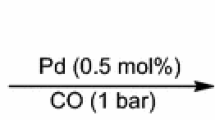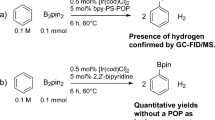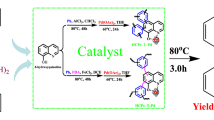Abstract
N-heterocyclic-carbene based polymers with abundant active sites and excellent stability are fascinating and highly desired while remain rare for the lack of easy synthetic protocols. In this article, an unprecedented strategy that employed a porous polyimidazolium (IPF-CSU-4) as the support for Pd(II) coordination was proposed to develop efficient heterogeneous catalyst. IPF-CSU-4 was constructed via a one-step quaternization chemistry between 2,4,6-tris(1-imidazolyl)-1,3,5-triazine and 1,4-bis(chloromethyl)benzene. The in-situ complexation of palladium (Pd) with carbene ligand of the polyimidazolium readily afforded a Pd-loaded porous polymeric network (Pd-PPc-4) with high stability. Pd-PPc-4 showed favorable accessibility to seven aryl halides substrates in Suzuki coupling reactions, with a catalytic yield up to 99% under mild conditions (3 h, 60 °C) and no obvious loss of activity even after five catalytic cycles. This provides new pathways for developing highly-efficient and stable catalysts through porous organic polymers for typical organic transformations.




Similar content being viewed by others
References
N. Miyaura, T. Yanagi, A. Suzuki, The palladium-catalyzed cross-coupling reaction of phenylboronic acid with haloarenes in the presence of bases. Synth. Commun. 11, 513–519 (1981). https://doi.org/10.1080/00397918108063618
D. Yu, J. Bai, J. Wang, H. Liang, C. Li, Assembling formation of highly dispersed Pd nanoparticles supported 1D carbon fiber electrospun with excellent catalytic active and recyclable performance for Suzuki reaction. Appl. Surf. Sci. 399, 185–191 (2017). https://doi.org/10.1016/j.apsusc.2016.12.065
J. Ruan, O. Saidi, J.A. Iggo, J. Xiao, Direct acylation of aryl bromides with aldehydes by palladium catalysis. J. Am. Chem. Soc. 130, 10510–10511 (2008). https://doi.org/10.1021/ja804351z
E.A.B. Kantchev, C.J. O’Brien, M.G. Organ, Palladium complexes of N-heterocyclic carbenes as catalysts for cross-coupling reactions—a synthetic chemist’s perspective. Angew. Chemie Int. Ed. 46, 2768–2813 (2007). https://doi.org/10.1002/anie.200601663
I.P. Beletskaya, A.V. Cheprakov, The heck reaction as a sharpening stone of palladium catalysis. Chem. Rev. 100, 3009–3066 (2000). https://doi.org/10.1021/cr9903048
J. Huang, W. Wang, H. Li, Water-medium organic reactions catalyzed by active and reusable Pd/Y heterobimetal-organic framework. ACS Catal. 3, 1526–1536 (2013). https://doi.org/10.1021/cs400094x
D.G. Brown, J. Boström, Analysis of past and present synthetic methodologies on medicinal chemistry: where have all the new reactions gone? J. Med. Chem. 59, 4443–4458 (2016). https://doi.org/10.1021/acs.jmedchem.5b01409
A. Molnár, Efficient, selective, and recyclable palladium catalysts in carbon−carbon coupling reactions. Chem. Rev. 111, 2251–2320 (2011). https://doi.org/10.1021/cr100355b
S.A. Sorokina, N.V. Kuchkina, B.P. Lawson, I.Y. Krasnova, N.A. Nemygina, L.Z. Nikoshvili, V.N. Talanova, B.D. Stein, M. Pink, D.G. Morgan, E.M. Sulman, L.M. Bronstein, Z.B. Shifrina, Pyridylphenylene dendrons immobilized on the surface of chemically modified magnetic silica as efficient stabilizing molecules of Pd species. Appl. Surf. Sci. 488, 865–873 (2019). https://doi.org/10.1016/j.apsusc.2019.05.141
B.M. Choudary, S. Madhi, N.S. Chowdari, M.L. Kantam, B. Sreedhar, Layered double hydroxide supported nanopalladium catalyst for heck-, suzuki-, sonogashira-, and stille-type coupling reactions of chloroarenes. J. Am. Chem. Soc. 124, 14127–14136 (2002). https://doi.org/10.1021/ja026975w
A. Corma, P. Concepcion, I. Dominguez, V. Forne, M. Sabater, Gold supported on a biopolymer (chitosan) catalyzes the regioselective hydroamination of alkynes. J. Catal. 251, 39–47 (2007). https://doi.org/10.1016/j.jcat.2007.07.021
G. Wei, W. Zhang, F. Wen, Y. Wang, M. Zhang, Suzuki reaction within the core-corona nanoreactor of poly(N-msopropylacrylamide)-grafted Pd nanoparticle in water. J. Phys. Chem. C. 112, 10827–10832 (2008). https://doi.org/10.1021/jp800741t
Q. Sun, Z. Dai, X. Meng, L. Wang, F.-S. Xiao, Task-specific design of porous polymer heterogeneous catalysts beyond homogeneous counterparts. ACS Catal. 5, 4556–4567 (2015). https://doi.org/10.1021/acscatal.5b00757
W. Wang, Y. Wang, C. Li, L. Yan, M. Jiang, Y. Ding, State-of-the-art multifunctional heterogeneous POP catalyst for cooperative transformation of CO2 to cyclic carbonates. ACS Sustain. Chem. Eng. 5, 4523–4528 (2017). https://doi.org/10.1021/acssuschemeng.7b00947
Z. Dai, Q. Sun, X. Liu, C. Bian, Q. Wu, S. Pan, L. Wang, X. Meng, F. Deng, F.-S. Xiao, Metalated porous porphyrin polymers as efficient heterogeneous catalysts for cycloaddition of epoxides with CO2 under ambient conditions. J. Catal. 338, 202–209 (2016). https://doi.org/10.1016/j.jcat.2016.03.005
X. Wang, X. Han, J. Zhang, X. Wu, Y. Liu, Y. Cui, Homochiral 2D porous covalent organic frameworks for heterogeneous asymmetric catalysis. J. Am. Chem. Soc. 138, 12332–12335 (2016). https://doi.org/10.1021/jacs.6b07714
J.K. Sun, W.W. Zhan, T. Akita, Q. Xu, Toward homogenization of heterogeneous metal nanoparticle catalysts with enhansced catalytic performance: soluble porous organic cage as a stabilizer and homogenizer. J. Am. Chem. Soc. 137, 7063–7066 (2015). https://doi.org/10.1021/jacs.5b04029
S.-Y. Ding, J. Gao, Q. Wang, Y. Zhang, W.-G. Song, C.-Y. Su, W. Wang, Construction of covalent organic framework for catalysis: Pd/COF-LZU1 in Suzuki-Miyaura coupling reaction. J. Am. Chem. Soc. 133, 19816–19822 (2011). https://doi.org/10.1021/ja206846p
Y. Qian, S.Y. Jeong, S.-H. Baeck, M.-J. Jin, S.E. Shim, A palladium complex confined in a thiadiazole-functionalized porous conjugated polymer for the Suzuki-Miyaura coupling reaction. RSC Adv. 9, 33563–33571 (2019). https://doi.org/10.1039/C9RA06709D
F. Wang, J. Mielby, F.H. Richter, G. Wang, G. Prieto, T. Kasama, C. Weidenthaler, H.-J. Bongard, S. Kegnaes, A. Fürstner, F. Schüth, A polyphenylene support for Pd catalysts with exceptional catalytic activity. Angew. Chemie Int. Ed. 53, 8645–8648 (2014). https://doi.org/10.1002/anie.201404912
Y. Dong, J. Bi, S. Zhang, D. Zhu, D. Meng, S. Ming, K. Qin, Q. Liu, L. Guo, T. Li, Palladium supported on N-heterocyclic carbene functionalized hydroxyethyl cellulose as a novel and efficient catalyst for the Suzuki reaction in aqueous media. Appl. Surf. Sci. 531, 147392 (2020). https://doi.org/10.1016/j.apsusc.2020.147392
R. Visbal, M.C. Gimeno, N-heterocyclic carbene metal complexes: photoluminescence and applications. Chem. Soc. Rev. 43, 3551–3574 (2014). https://doi.org/10.1039/C3CS60466G
S. Wang, X. Wang, Imidazolium ionic liquids, imidazolylidene heterocyclic carbenes, and zeolitic imidazolate frameworks for CO2 capture and photochemical reduction. Angew. Chemie Int. Ed. 55, 2308–2320 (2016). https://doi.org/10.1002/anie.201507145
O. Schuster, L. Yang, H.G. Raubenheimer, M. Albrecht, Beyond conventional N-heterocyclic carbenes: abnormal, remote, and other classes of NHC ligands with reduced heteroatom stabilization. Chem. Rev. 109, 3445–3478 (2009). https://doi.org/10.1021/cr8005087
D.J. Nelson, S.P. Nolan, Quantifying and understanding the electronic properties of N-heterocyclic carbenes. Chem. Soc. Rev. 42, 6723 (2013). https://doi.org/10.1039/c3cs60146c
J.C.Y. Lin, R.T.W. Huang, C.S. Lee, A. Bhattacharyya, W.S. Hwang, I.J.B. Lin, Coinage metal-N-heterocyclic carbene complexes. Chem. Rev. 109, 3561–3598 (2009). https://doi.org/10.1021/cr8005153
J. Choi, H.Y. Yang, H.J. Kim, S.U. Son, Organometallic hollow spheres bearing bis(N-heterocyclic carbene)-palladium species: catalytic application in three-component strecker reactions. Angew. Chemie Int. Ed. 49, 7718–7722 (2010). https://doi.org/10.1002/anie.201003101
H.C. Cho, H.S. Lee, J. Chun, S.M. Lee, H.J. Kim, S.U. Son, Tubular microporous organic networks bearing imidazolium salts and their catalytic CO2 conversion to cyclic carbonates. Chem. Commun. 47, 917–919 (2011). https://doi.org/10.1039/C0CC03914D
K. Thiel, R. Zehbe, J. Roeser, P. Strauch, S. Enthaler, A. Thomas, A polymer analogous reaction for the formation of imidazolium and NHC based porous polymer networks. Polym. Chem. 4, 1848 (2013). https://doi.org/10.1039/c2py20947k
E. Troschke, K.D. Nguyen, S. Paasch, J. Schmidt, G. Nickerl, I. Senkovska, E. Brunner, S. Kaskel, Integration of an N-heterocyclic carbene precursor into a covalent triazine framework for organocatalysis. Chem. A Eur. J. 24, 18629–18633 (2018). https://doi.org/10.1002/chem.201804373
S. Yang, Q. Zhang, Y. Hu, G. Ding, J. Wang, S. Huo, B. Zhang, J. Cheng, Synthesis of s-triazine based tri-imidazole derivatives and their application as thermal latent curing agents for epoxy resin. Mater. Lett. 216, 127–130 (2018). https://doi.org/10.1016/j.matlet.2017.12.122
X. Yu, J. Sun, J. Yuan, W. Zhang, C. Pan, Y. Liu, G. Yu, One-pot synthesis of an ionic porous organic framework for metal-free catalytic CO2 fixation under ambient conditions. Chem. Eng. J. 350, 867–871 (2018). https://doi.org/10.1016/j.cej.2018.05.175
M. Lin, S. Wang, J. Zhang, W. Luo, H. Liu, W. Wang, C.-Y. Su, Guest uptake and heterogeneous catalysis of a porous Pd(II) N-heterocyclic carbene polymer. J. Mol. Catal. A Chem. 394, 33–39 (2014). https://doi.org/10.1016/j.molcata.2014.06.039
T.W. van Deelen, C. Hernández Mejía, K.P. de Jong, Control of metal-support interactions in heterogeneous catalysts to enhance activity and selectivity. Nat. Catal. 2, 955–970 (2019). https://doi.org/10.1038/s41929-019-0364-x
W.-Y. Wu, S.-N. Chen, F.-Y. Tsai, Recyclable and highly active cationic 2,2′-bipyridyl palladium(II) catalyst for Suzuki cross-coupling reaction in water. Tetrahedron Lett. 47, 9267–9270 (2006). https://doi.org/10.1016/j.tetlet.2006.10.127
P. Zhang, Z. Weng, J. Guo, C. Wang, Solution-dispersible, colloidal, conjugated porous polymer networks with entrapped palladium nanocrystals for heterogeneous catalysis of the Suzuki-Miyaura coupling reaction. Chem. Mater. 23, 5243–5249 (2011). https://doi.org/10.1021/cm202283z
M.K. Bhunia, S.K. Das, P. Pachfule, R. Banerjee, A. Bhaumik, Nitrogen-rich porous covalent imine network (CIN) material as an efficient catalytic support for C-C coupling reactions. Dalt. Trans. 41, 1304–1311 (2012). https://doi.org/10.1039/C1DT11350J
L. Geng, Y. Li, Z. Qi, H. Fan, Z. Zhou, R. Chen, Y. Wang, J. Huang, Highly efficient palladium catalysts supported on nitrogen contained polymers for Suzuki-Miyaura reaction. Catal. Commun. 82, 24–28 (2016). https://doi.org/10.1016/j.catcom.2016.04.011
G. Liu, M. Hou, T. Wu, T. Jiang, H. Fan, G. Yang, B. Han, Pd(II) immobilized on mesoporous silica by N-heterocyclic carbene ionic liquids and catalysis for hydrogenation. Phys. Chem. Chem. Phys. 13, 2062 (2011). https://doi.org/10.1039/c0cp01213k
X. Gou, T. Liu, Y. Wang, Y. Han, Ultrastable and highly catalytically active N-heterocyclic-carbene-stabilized gold nanoparticles in confined spaces. Angew. Chemie Int. Ed. (2020). https://doi.org/10.1002/anie.202006569
Y. Liu, B. Lou, L. Shangguan, J. Cai, H. Zhu, B. Shi, Pillar[5]arene-based organometallic cross-linked polymer: synthesis, structure characterization, and catalytic activity in the Suzuki-Miyaura coupling reaction. Macromolecules 51, 1351–1356 (2018). https://doi.org/10.1021/acs.macromol.7b02701
M.I. Burguete, E. García-Verdugo, I. Garcia-Villar, F. Gelat, P. Licence, S.V. Luis, V. Sans, Pd catalysts immobilized onto gel-supported ionic liquid-like phases (g-SILLPs): a remarkable effect of the nature of the support. J. Catal. 269, 150–160 (2010). https://doi.org/10.1016/j.jcat.2009.11.002
Z. Guan, J. Hu, Y. Gu, H. Zhang, G. Li, T. Li, PdCl2(py)2 encaged in monodispersed zeolitic hollow spheres: a highly efficient and reusable catalyst for Suzuki-Miyaura cross-coupling reaction in aqueous media. Green Chem. 14, 1964 (2012). https://doi.org/10.1039/c2gc35302d
S.-W. Kim, J. Park, Y. Jang, Y. Chung, S. Hwang, T. Hyeon, Y.W. Kim, Synthesis of monodisperse palladium nanoparticles. Nano Lett. 3, 1289–1291 (2003). https://doi.org/10.1021/nl0343405
L. Botella, C. Nájera, Cross-coupling reactions with boronic acids in water catalysed by oxime-derived palladacycles. J. Organomet. Chem. 663, 46–57 (2002). https://doi.org/10.1016/S0022-328X(02)01727-8
D.A. Alonso, C. Nájera, M.C. Pacheco, Highly active oxime-derived Palladacycle complexes for Suzuki−Miyaura and Ullmann-type coupling reactions. J. Org. Chem. 67, 5588–5594 (2002). https://doi.org/10.1021/jo025619t
V.V. Grushin, H. Alper, Transformations of chloroarenes, catalyzed by transition-metal complexes. Chem. Rev. 94(4), 1047–1062 (1994). https://doi.org/10.1021/cr00028a008
Acknowledgements
We acknowledge the financial support from the National Science Foundation of China (Nos. 21674129, 51873232 and 21636010).
Author information
Authors and Affiliations
Corresponding authors
Ethics declarations
Conflict of interest
We declare that we do not have any commercial or associative interest that represents a conflict of interest in connection with the work submitted.
Additional information
Publisher's Note
Springer Nature remains neutral with regard to jurisdictional claims in published maps and institutional affiliations.
Electronic supplementary material
Below is the link to the electronic supplementary material.
Appendix: Supplementary data
Appendix: Supplementary data
Synthetic route of 2,4,6-tris(1-imidazolyl)-1,3,5-triazine (Fig. S1), (a) 1H NMR spectrum; (b) 13C NMR spectrum; and (c) FT-IR spectrum of triimidazolyl triazine (Fig. S2), FT-IR spectra of IPF-CSU-4 obtained at 70°C, 120°C, 150°C, and 180°C (Fig. S3), SEM spectroscopy of (a) IPF-CSU-4 and (b) Pd-PPc-4 (Fig. S4), TEM spectroscopy of Pd-PPc-4 (Fig. S5), (a) CH4 and (b) CO2 adsorption/desorption isotherms of IPF-CSU-4 and Pd-PPc-4 (Fig. S6), Mass spectrum of IPF-CSU-4 (Fig. S7), Proposed mechanism of Suzuki reaction catalyzed by Pd-PPc-4 (Fig. S8), Pore parameters of the polymers IPF-CSU-4 and Pd-PPc-4 (Table S1), Catalytic condition optimization of Suzuki coupling reaction (Table S2), 1H NMR spectrum of catalytic products (Figs. S9–11).
Rights and permissions
About this article
Cite this article
Li, X., Yu, X., Zhang, W. et al. Effective Suzuki coupling reaction enabled by palladium–polycarbene catalyst derived from porous polyimidazolium. J Porous Mater 29, 601–608 (2022). https://doi.org/10.1007/s10934-021-01193-y
Accepted:
Published:
Issue Date:
DOI: https://doi.org/10.1007/s10934-021-01193-y




